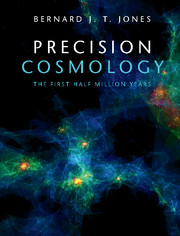Book contents
- Frontmatter
- Dedication
- Contents
- Preface
- Notation and Conventions
- Part I 100 Years of Cosmology
- Part II Newtonian Cosmology
- 5 Newtonian Cosmology
- 6 Dark Energy Cosmological Models
- 7 The Early Universe
- 8 The Inhomogeneous Universe
- 9 The Inflationary Universe
- Part III Relativistic Cosmology
- Part IV The Physics of Matter and Radiation
- Part V Precision Tools for Precision Cosmology
- Appendix A SI, CGS and Planck Units
- Appendix B Magnitudes and Distances
- Appendix C Representing Vectors and Tensors
- Appendix D The Electromagnetic Field
- Appendix E Statistical Distributions
- Appendix F Functions on a Sphere
- Appendix G Acknowledgements
- References
- Index
8 - The Inhomogeneous Universe
from Part II - Newtonian Cosmology
Published online by Cambridge University Press: 04 May 2017
- Frontmatter
- Dedication
- Contents
- Preface
- Notation and Conventions
- Part I 100 Years of Cosmology
- Part II Newtonian Cosmology
- 5 Newtonian Cosmology
- 6 Dark Energy Cosmological Models
- 7 The Early Universe
- 8 The Inhomogeneous Universe
- 9 The Inflationary Universe
- Part III Relativistic Cosmology
- Part IV The Physics of Matter and Radiation
- Part V Precision Tools for Precision Cosmology
- Appendix A SI, CGS and Planck Units
- Appendix B Magnitudes and Distances
- Appendix C Representing Vectors and Tensors
- Appendix D The Electromagnetic Field
- Appendix E Statistical Distributions
- Appendix F Functions on a Sphere
- Appendix G Acknowledgements
- References
- Index
Summary
In this chapter we deal with the equations that govern the evolution of inhomogeneous cosmological models within the framework of Newtonian theory. After a brief overview we discuss how to describe an inhomogeneous Universe in which the density varies randomly from point to point. Then we go on to look at slightly inhomogeneous models. First we cover pressure-free models, and then small amplitude perturbations where pressure might play a part both prior to and after the recombination epoch.
Finally we discuss the brief period during which, after 380 000 yr, the Universe emerges from the fireball. The decoupling of the matter and radiation fields leaves an important imprint on the observed structure, the so-called ‘Baryonic Acoustic Oscillations’ or BAOs. These baryonic acoustic oscillations are seen both in the cosmic background radiation field and in the distribution of galaxies and provide important cosmological information with high accuracy.
Evolution of Inhomogeneous Models
The Universe today is manifestly inhomogeneous: it is filled with stars, galaxies and clusters of galaxies. From observations of the cosmic background radiation, we know that it was far more homogeneous in the past than it is now. Indeed, at a redshift of ~ 1100 when the Universe emerged from the fireball phase of the expansion, the degree of inhomogeneity on all scales was far less than 1%. However, the degree of inhomogeneity at that time was measurably not zero: there was some structure at that time. The galaxies and clusters of galaxies must have grown from that initially almost homogeneous state.
The force responsible for that growth was the force of gravity acting on the small fluctuations so as to amplify them until they separate out from the background Universe and collapse to form the large scale systems we see today.
Gravitational Instability
The idea of gravitational instability being responsible for the origin of cosmic structure goes back to the work of Poincaré and Jeans, but the issue of the stability of general relativistic cosmological models can be traced back to the work of McCrea and McVittie (1930); McVittie (1931, 1932, 1933) who built directly on the work of Lemaître (1927) and Robertson (1929). The paper of McVittie (1932) was the first to build a so-called Swiss cheese model for an inhomogeneity.
- Type
- Chapter
- Information
- Precision CosmologyThe First Half Million Years, pp. 187 - 207Publisher: Cambridge University PressPrint publication year: 2017



